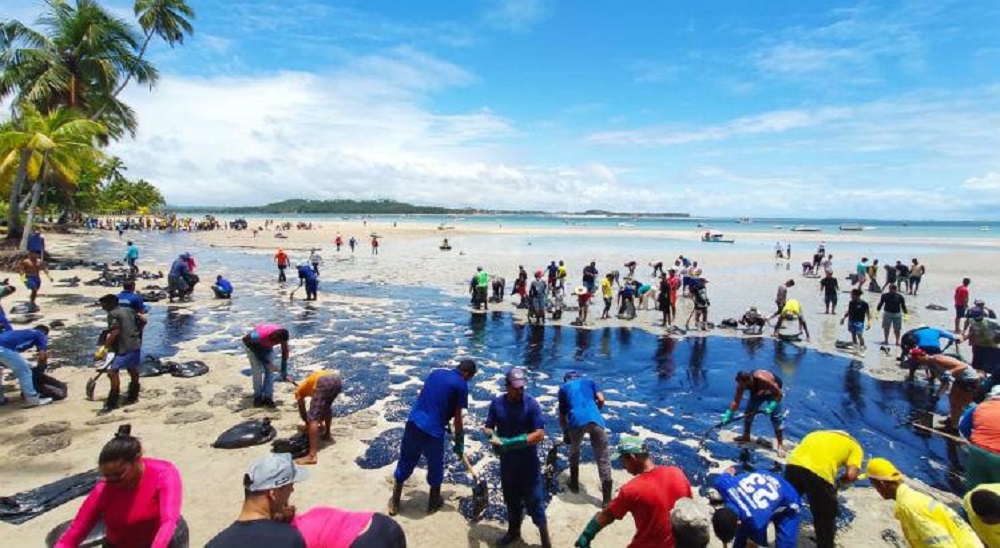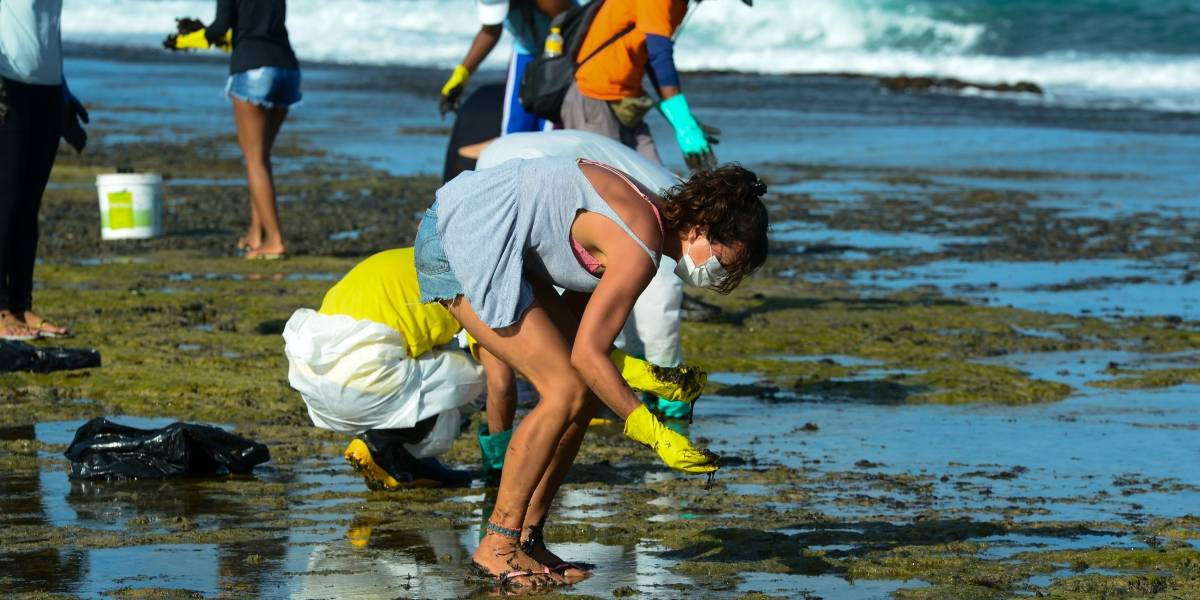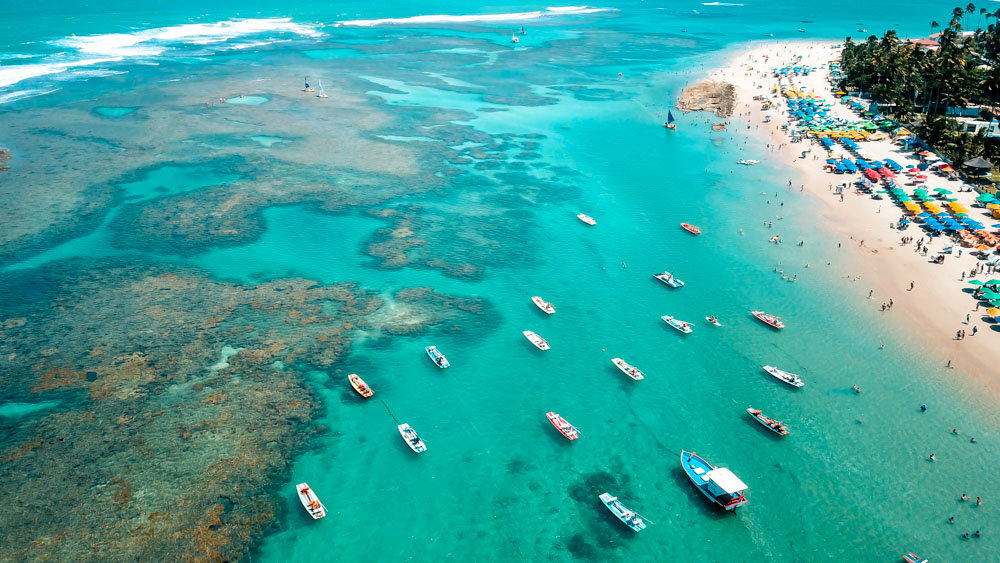RIO DE JANEIRO, BRAZIL – The oil spill that has affected some of Pernambuco state’s most popular beaches in recent days has set alarm bells ringing among the merchants who live off tourism, but it is not yet affecting their daily lives.

On Wednesday, October 23rd, the secretary of Tourism of Pernambuco and sector representatives met in Brasília with federal Tourism Minister Marcelo Álvaro Antônio to discuss preventive and informative measures, so that the coast of Pernambuco, particularly south of the capital Recife, remains a tourist destination next summer.
Environment Minister Ricardo Salles took over the national radio and TV network to ensure that the government has committed itself to address the crisis.
Also on Wednesday, the oil reached two more locations: Barra de Jangada beach, in Jaboatão, next to the capital Recife; and Janga beach, in the city of Paulista, next to Olinda. Nearby, in Itapissuma, the oldest fishing colony in Greater Recife now sees the number of clients drop for fear of contamination – even though the site has not been affected. In all, 28 beaches in the state have been affected over the past 50 days.
Amarildes Pessoa, 65, a fisherman “since he was born,” says that both tourists and local customers fear that the fish in the region are contaminated. Besides sheltering the Z10, the oldest fishing colony in Greater Recife, Itapissuma is famous for its ‘caldeirada’, a seafood dish typical of the northern coast of Pernambuco that attracts many tourists’ interest. Some restaurant owners deny that customer frequency has decreased. But Pessoa guarantees that in the last week, sales have dropped “about 40 percent”.
He fishes for shrimp, Charru mussel, oysters, mangrove crab, among others, on the Santa Cruz channel. And, in addition to selling to fishmongers and supplying the city, he sells his products on the tourist island of Itamaracá, in Olinda, Recife, among other locations. “I didn’t think it would drop that much. The oil has not yet reached here, thank God, but if the people are afraid to eat… then they won’t buy it”, he says. He claims that the grievance extends to other colleagues in the fishing colony. “There are clients saying that they will not eat fish and crustaceans for three months. It’s no joke, my son”.
The Itapissuma region, on the northern coast of Pernambuco, consists of mangroves. If the oil reaches these areas, its removal is virtually impossible, according to experts. It is in this rich ecosystem that Isaías Américo, 42, looks for the oysters he sells. Unlike Pessoa, he guarantees that he can still sell them regularly. “But if the oil gets here, it’s over,” he laments.

Thirty minutes away, on Janga beach, in the municipality of Paulista, hundreds of volunteers were trying to remove a large volume of crude and very thick oil from the water and the rocks, which reached them on Wednesday.
As on other days, they carried out a joint effort with the donation of supplies and equipment from the Pernambucans who showed their solidarity. Among these volunteers, a man in the water was sieving for dead fish.
According to municipal representatives, local marine life may be endangered, but they guarantee that samples of dead animals will be sent to the Federal University of Pernambuco to assess what the relationship is with the leak.
The main concern lies on the other side of Greater Recife, on the southern coast of Pernambuco, particularly in municipalities such as Tamandaré, Ipojuca, Cabo de Santo Agostinho and Jaboatão. In this last city, which borders on Recife, less than 20 kilometers from the famous Boa Viagem beach, the oil landed at dawn on Wednesday. But the city government said it was monitoring the area and was able to contain the contamination in time, removing about five tons of the substance by the end of the morning.
The most important cities for tourism in Pernambuco are Tamarandé and Ipojuca. In first place is the tourist beach of Carneiros, which was contaminated last Friday – and has already been cleaned by tireless volunteers. The latter houses a spa that includes the beaches of Porto de Galinhas, Muro Alto, Maracaípe, and Cupe.
The first of these was just barely spared from the leak, but the others were affected. Tourism employs 50 percent of the economically active population in this resort alone, according to the Porto Convention. Considering all of Ipojuca, 20,000 of its 94,000 inhabitants are employed in the sector.
Pernambuco’s Secretary of Tourism says that 5.9 million people visited the state in 2018. And that Porto de Galinhas is the most visited beach in the entire state. According to the Porto Convention, 1.2 million tourists visited the area last year.
Another factor of concern is that the southern coast of Pernambuco is rimmed by coral reefs. Once affected by crude oil, it is virtually impossible to remove it from the rocks.

So far, the oil contamination in the region seems not to have affected the plans of tourists who will visit the southern coast of Pernambuco. El País spoke with people running inns in Maracaípe, Carneiros, and Olinda – the latter, although farther away, is one of the main lodging points for those who visit the region’s beaches.
According to them, there have been no cancellation requests yet. The routine is virtually the same. “On Saturday, when the contamination occurred, many people called asking to cancel, but we managed to reverse 90 percent of these cancellations. Now we have to see from now on”, says Fátima Cristina Dias, owner of the Maraoka pousada, on Maracaípe beach.
In recent days she has published photos of the beach on Instagram, which has already been cleaned by volunteers. She guarantees that demand has increased, while reservation cancellations have returned to their normal flow.
“We, the tourist trade and hotel owners of Porto de Galinhas, are in preventive mode. The beaches of Carneiros and Porto de Galinhas had occasional incidents, but they are clean. We want to avoid these negative effects of cancellation now,” explains Danilo Oliveira, vice-president of the Association for the Sustainable Development of Carneiros and director of the Praia dos Carneiros inn.
He was at the meeting with the Minister of Tourism and the Secretary of Tourism of Pernambuco on Wednesday. Among the demands are measures to promote destinations in the Northeast and a positive media operation for the region, preventing changes in tourist flow.
“That would be a catastrophe. What is happening, at least until now, are customer requests that we ensure that there are no problems and that the beaches are suitable for bathing. But no one has asked to cancel the reservation, thank God,” he says.
Oliveira assures that the beaches in the region that have been cleaned are now suitable for bathing. But this is not 100 percent safe. According to oceanographer Moacyr Araújo, vice-rector of the Federal University of Pernambuco, people should avoid entering the areas affected by oil and consuming fish and seafood until the level of contamination is known.
At a press conference after a meeting of Governor Paulo Câmara with the academic community, he said that new oil slicks could emerge in the coming days.
“More oil is coming in. It is estimated that approximately 30 to 40 percent of everything we are seeing is still in the ocean,” he said. “There is a current that carries it from Africa to Central and South America. And that’s the natural motion of currents. But there are parts of these currents that are denser, stronger and more intense. And it is currently traveling along the eastern edge of the Northeast, that is, between Rio Grande do Norte and Bahia, through a geophysical configuration of winds and other factors. So at some point, the current will push the slick toward the closest state,” he added.
Source: El País

